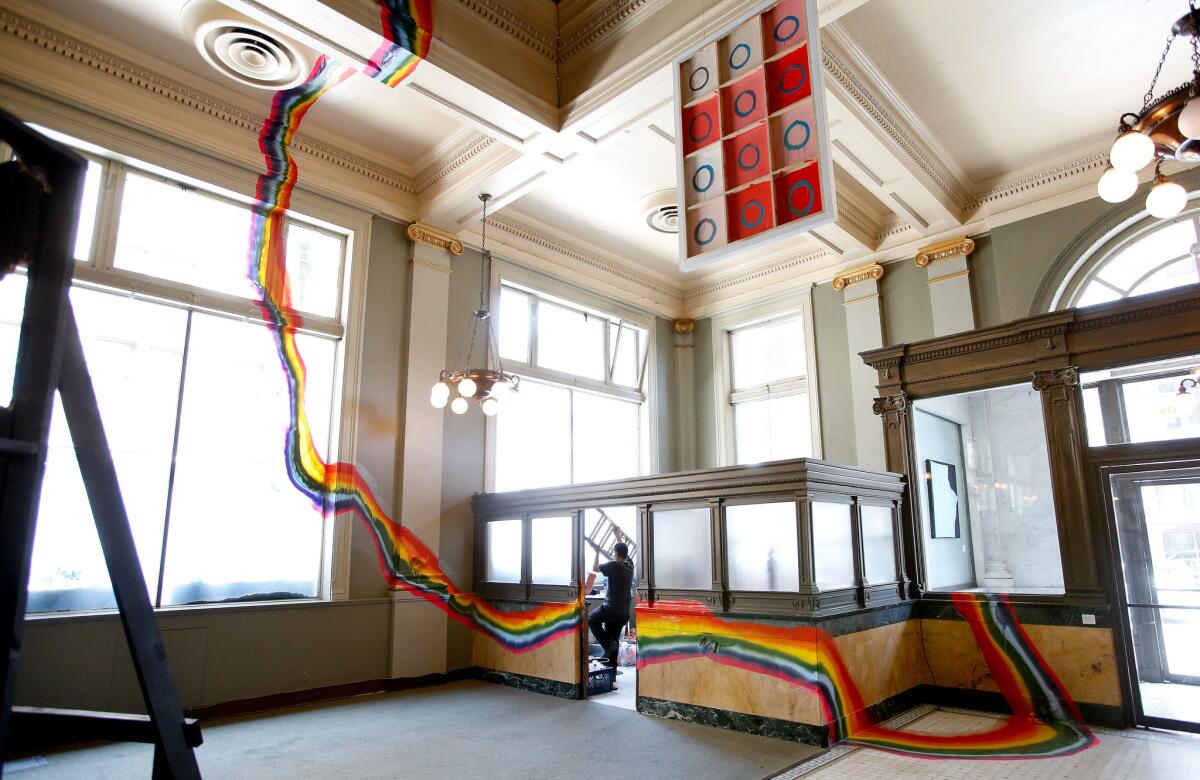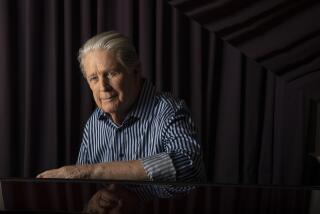Los Angeles’ art world is bigger and wider

- Share via
On a hot, arid, mid-August evening at the small but splendid Episcopal Church of the Epiphany in Lincoln Heights, the tower’s sonorous bell rang. Red double-doors opened wide, and a few hundred people filed inside, filling the pews in the handsome English Gothic Revival interior.
They had not come for vespers. They had come to see art. Performance art.
Jeffrey Vallance volleyed questions about his illuminated Vallance Bible, a highly personal 2011 revision of the sacred Christian text, in queries tossed by Brother Tom Carey, vicar of the historic church. (Dating to 1887, it’s a community anchor where Cesar Chavez once organized support for the farmworkers’ movement and Chicano students assembled to prepare protests to the Vietnam War.) Then, with musician Robert Crouch, Julie Tolentino did a movement performance within a landscape of sound.
Fall arts preview 2014: The season in music, theater and more
A pair of high-profile performances by two well-known artists is not in itself out of the ordinary. But the double bill was the debut event in a performance art series planned for the church. Taking place in a largely residential neighborhood northeast of downtown Los Angeles, they could be said to be emblematic of a relatively recent shift: Slowly but surely, the L.A. art world’s center of gravity has been tilting to the east.
The public face of L.A. art has long been peripatetic, but since the 1950s it’s typically been assumed to be centered on the city’s Westside. (Think Venice Beach to Fairfax Avenue, south of the hills.) Anyone can think of exceptions to the rule, but that’s what they are — exceptions.
No longer. Economic and demographic changes are having an effect.
In a vast city like Los Angeles, where far-flung sprawl is a given, art of course turns up all over the place. West of Rome, the inventive nonprofit that organized the Epiphany Church performances, has presented exhibitions in spaces everywhere from Westwood to Pasadena in the last nine years. And artists have always taken advantage of the city’s spread, ferreting out living and working space throughout the region.
L.A.’s art galleries are different. As a service industry, they have typically prospered in communities adjacent to the residential areas where collectors are presumed to live. A prominent dealer on the prowl for a new Westside gallery space once told me, with only a hint of mischief, that he began his search by making a list of high-end pet groomers and dry cleaning shops, and then looked for nearby vacancies. That’s why West Hollywood, Santa Monica and, more recently, Culver City prospered as gallery sites.
Now, though, Hollywood and downtown are solidifying as essential gallery destinations.
Galleries have been downtown since the 1980s, of course, when several dozen clustered in an area adjacent to the Museum of Contemporary Art’s newly opened Little Tokyo outpost. (Most disappeared in the early ‘90s economic downturn.) More recently, funky storefronts in Chinatown were de rigueur. Today, for new or newly relocating galleries, both commercial and nonprofit, it’s industrial warehouses — with plenty of parking — south of the 10 Freeway and east of the L.A. River.
Closer to the city center, the powerhouse gallery Hauser & Wirth opens in January in partnership with former museum curator Paul Schimmel, inaugurating a mammoth, 100,000-square-foot complex in an old, unused flour mill on East 3rd Street. With sleek spaces in Zurich, London and New York, the gallery has built much of its international profile representing L.A.-based artists — a stable that includes Mark Bradford, Thomas Houseago, Richard Jackson, Rachel Khedoori, Paul McCarthy, Sterling Ruby and Diana Thater. The new branch represents a kind of homecoming.
Speaking of MOCA, the once shaky institution is getting back on its feet, while across Grand Avenue, the blue-chip Broad Collection will be its new neighbor when it opens to the public, free of charge, sometime next year. Seven blocks away, downtown developer Tom Gilmore even envisions a 50,000-square-foot art exhibition space and rooftop sculpture garden for his revitalized Old Bank District, around 4th and Main Street.
Like downtown, Hollywood has also long had a smattering of worthwhile galleries, but it took a big leap two years ago. That’s when Regen Projects opened on a gritty stretch of Santa Monica Boulevard, just east of Highland Avenue, in large, impressive quarters designed by celebrated architect Michael Maltzan. Now close to a dozen galleries, large and small, cluster in the vicinity — including some that have moved east from Venice and West Hollywood. Midway from there to Culver City’s gallery row, Kayne Griffin Corcoran and David Kordansky have opened, shifting the locations of their prominent, established Westside galleries to the east.
And not so long ago, who could have imagined a private art museum east of Highland on Wilshire Boulevard? Last year art collector and MOCA trustee Maurice Marciano acquired, with his brother Paul, the monumental Scottish Rite Masonic Temple to house a 1,000-piece collection. (In order to avoid any conflicts of interest with his subsequent co-chairmanship of MOCA, the project is temporarily on hold.) The block-long, four-story building, a nominal white elephant, had sat mostly unused since 1994.
The languishing Masonic temple was a victim of ordinary social evolution (membership deteriorated) coupled with the same national economic woes that wiped away downtown’s galleries. Related forces are at work now. Hollywood and downtown are generally less expensive than the increasingly tech-heavy Westside with its so-called Silicon Beach.
The city’s population is also changing. According to the U.S. census, Los Angeles-Long Beach-Anaheim is now the nation’s most densely populated urbanized area, with nearly 7,000 people per square mile. Pockets of the San Fernando and San Gabriel valleys are thickly settled, but a check of The Times’ map of neighborhood density shows that Koreatown, four miles east of the Los Angeles County Museum of Art, ranks as the most thickly populated in the city, its true urban core. It’s surrounded by many — if not most — of L.A.’s similarly crowded communities.
None of this means that the Westside is languishing. Development around Santa Monica’s Bergamot Station has negatively affected its gallery life, but Culver City’s lively galleries remain the most numerous. The UCLA Hammer Museum and Santa Monica Museum of Art are unlikely to abandon their namesake locales, while the Getty sparkles on a Brentwood hilltop and in Pacific Palisades. Count on L.A. Louver to remain rooted to its enviable spot a few hundred yards from Venice Beach.
Still, as the fall art season gets underway, definitive signs of an eastward tilt are inescapable. That’s a good thing — and not just because swelling traffic makes crosstown commutes increasingly grim. It’s good because there’s something to be said for the public face of art more closely matching where the public is.
More to Read
The biggest entertainment stories
Get our big stories about Hollywood, film, television, music, arts, culture and more right in your inbox as soon as they publish.
You may occasionally receive promotional content from the Los Angeles Times.











